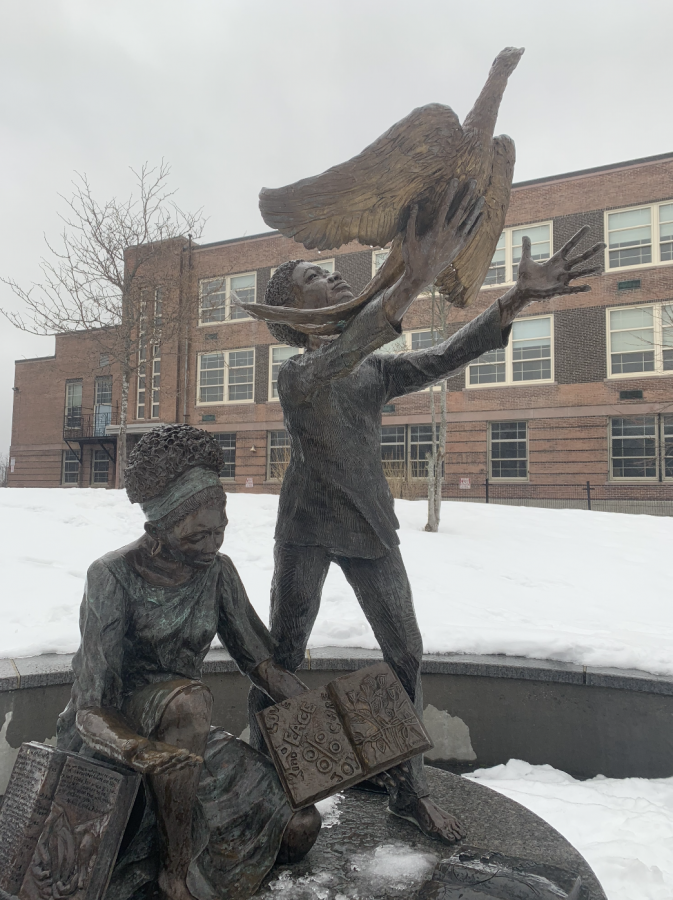Boston parks memorialize Clarence Jones, other prominent Black figures
“The Value of a Life” is a memorial by Fern Cunningham located at the edge of Jeep Jones Park that honors the youth of Boston.
February 19, 2021
In recognition of Black History Month, the Parks and Recreation department of the City of Boston has put out a list highlighting some of the public parks named after historical Black figures. The list features four locations throughout the city — Ramsay Park, Gourdin Park, Harriet Tubman Square and Jeep Jones Park — that are named in recognition of important civil rights activists, veterans and public officials.
Throughout the month, Boston Parks and Recreation has been posting informative tweets regarding the leaders that the parks were named after. They tweeted Saturday, Feb. 13, about Edward Gourdin, whom Gourdin Park was named after.
“Justice Edward O. Gourdin was the first Black judge appointed to the Roxbury District Court and the first Black person in New England appointed to the Massachusetts Supreme Court,” the tweet said.
The City of Boston has published tweets bringing light to historical Black landmarks, short stories about Black figures and educational resources and programs to celebrate Black History Month. They’ve also been reposting the work of other departments, such as the Office of Arts and Culture, that highlight different Black-owned businesses and initiatives. On Feb. 8, they posted a short video about the Black Heritage Trail and how people could learn more about it.
“Looking for a way to celebrate #BlackHistoryMonth this weekend? Take a stroll along the Black Heritage Trail. You can immerse yourself in the history of Black Boston by downloading the audio tour app or printable map of the 1.6 mile walking tour,” the tweet said.
Jeep Jones Park in Roxbury, named after Clarence “Jeep” Jones, is one of the parks listed by the department of Parks and Recreation. Jones, who passed away during Black History Month last year, was known for his activism and involvement within the Roxbury community. Jones was elected as the deputy mayor of Boston in 1976, making him the first Black man in that position as well as the highest ranking Black public official in Boston’s history at the time.
Before his position as deputy mayor, Jones was on the board of Boston’s Youth Activities Commission and the Office of Human Rights. He was cherished by his community for the programs he led and was known as a role model. Jones attended Winston-Salem State College, which made him an even bigger figurehead in Roxbury, since he was one of only a few from the community to get a higher education.
Jones — a veteran, activist, public official and community leader — was awarded an honorary doctorate in public service by Northeastern in 2005. He was also a part of the university’s Lower Roxbury Black History Project.
Franklin Grear, a second-year politics, philosophy and economics student at Northeastern, is a current resident of Roxbury. Although he has never been to Jeep Jones Park, he has heard of its mention in the community and said he believes it’s important to name public spaces after prominent figures.
“If it’s someone that’s good to look up to and is relevant to the community, or someone the community can see themselves in, then it’s important,” Grear said.
Commemorating public spaces by attaching the name of a community figurehead to them is a practice long repeated throughout history. There are countless examples throughout Boston of such spaces, including M.L.K. Jr. Boulevard, Malcolm X House and the Florida Ruffin Ridley School. By choosing people who left a distinct mark on the populations utilizing the space, the importance of the name grows, acting as a reminder of a real member of the community who was able to make a difference.







